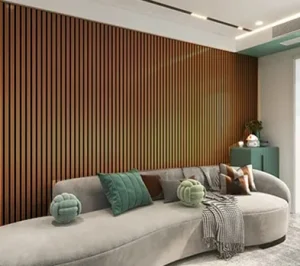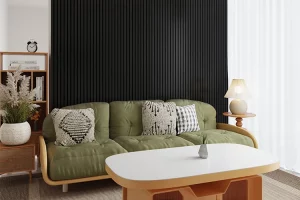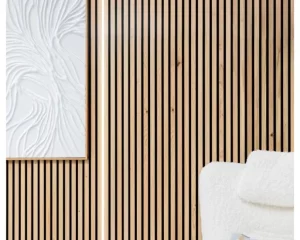Avoid your inquiry is delay response, please enter your WhatsApp/Skype along with the message, so we can contact you at the very first time.
We will reply you within 24 hours. If for urgent case, please add WhatsApp/WeChat: +86-13678899682 directly.
Hard rooms echo, voices blur, and meetings drag. Install acoustic slat wood wall panels to absorb sound waves and calm the space—without losing the warmth of natural wood.
Yes. Acoustic slat wood wall panels combine wooden slats with an acoustic backing designed to absorb sound waves and cut echo. When mounted over a cavity or mineral wool, many systems reach NRC ≈ 0.8–0.9, which indicates strong sound absorption and noticeably better speech clarity.
We are a professional manufacturer in China specializing in high-quality PET and wood acoustic panels for global B2B clients. We provide OEM/ODM wood slat acoustic panels, customize sizes, finishes, and slat configurations, and deliver stable lead times for distributors, architects, contractors, and brand owners.
An acoustic slat panel is a wood wall panel made of narrow wooden slats bonded to an acoustic backing such as felt or mineral wool. The face pattern scatters the sound wave while the porous layer is designed to absorb that energy and convert sound energy to a tiny amount of heat. This acoustic treatment reduces reflections so speech becomes clear and the room sounds calm.

wooden acoustic slat panels wall
The science behind acoustic panels is straightforward: porous absorption works best when air can move through fibers. A small air gap behind the slatted wall extends low-mid performance. Add mineral wool for deeper sound absorption, especially in the speech range (500–2000 Hz).
“Absorption controls echo inside a room; isolation blocks sound between rooms. Use the right solution for each job.”
Stats & facts:
Acoustic panels work for soundproofing only a little. Their main role is sound absorption inside the room. If you need to block noise between rooms, use heavy layers (double gypsum, concrete wall), airtight sealing, and decoupling. Then use acoustic slat wall panels inside to improve sound quality for people in the room.
Quick checklist
Technical benefits
Design benefits
Operational benefits
Use slat wall panels wherever speech intelligibility matters and surfaces are hard: meeting rooms, classrooms, reception areas, cafés, libraries, and retail. In these settings the combination of diffusion and absorption trims early reflections and creates a balanced and controlled acoustic environment.
Large lobbies and open offices also benefit. Cover 15–30% of hard area and distribute panels across opposing surfaces. Add PET ceiling baffles to catch extra paths on the wall or ceiling. For a quick visual and acoustic upgrade, start with a feature acoustic wall behind reception and a partial canopy above teamwork zones.

slat wall panels in a meeting room
Face & slot pattern. Narrow slats with wider slot openings admit more mid-high energy to the backing; wider slats provide extra diffusion.
Backing. The ability to absorb depends on the porous layer (felt or mineral wool). Felt excels at mid/highs; mineral wool lifts low-mids.
Depth. A 20–50 mm cavity behind the wood panel expands the bandwidth.
Species & finish. Different wood species mostly affect look. Choose oak, walnut, or ash to match interiors; performance is driven chiefly by the slot pattern and what sits behind it.
Pro tip: when you need warm aesthetics and robust performance, a hybrid build—slat panel face + felt + 25–90 mm wool—delivers high NRC without bulky foam panels. These wooden acoustic panels keep the design coherent while raising the technical result.
Substrate. Ensure the surface is flat and dry: gypsum board, plywood, or concrete wall are common.
Fixing. Glue to battens or screw through the face into furring; align joints so the rhythm stays true.
Cavity. If space allows, leave 20–50 mm; add mineral wool for extra performance.
Ceiling use. Panels can mount on a grid; use safe anchors and consider access to MEP.
Fire & codes. Verify rating of backing and adhesives; check local requirements for public spaces.
Because panels are typically modular, two installers can complete a small feature wall in a few hours. Pre-cut openings for outlets keep edges clean. Installing wood slats rewards careful layout and accurate measurements.
A quick planning table for common uses:
| Room type | Typical baseline RT60 | Target RT60 | Recommended coverage of hard area |
|---|---|---|---|
| Huddle/phone room | 0.7–0.9 s | 0.35–0.45 s | 20–30% |
| Meeting room (6–10 ppl) | 0.9–1.2 s | 0.45–0.6 s | 20–30% |
| Classroom | 1.0–1.3 s | 0.5–0.6 s | 25–35% |
| Open office | 1.2–1.6 s | 0.6–0.8 s | 15–25% |
Spread modules to intercept first reflections and opposing surfaces. If the room still feels “live,” add more coverage—especially near glass. This is controlling sound where it matters most.
Independent reports on acoustic slat wood wall panels show how mounting changes results:
| Sample & mounting | NRC | Notes |
|---|---|---|
| Direct to wall (Type A) | 0.54 | Slatted face over felt only |
| On furring with ~20 mm cavity | 0.82 | Slots + cavity boost the mid band |
| Over ~90 mm mineral wool | 0.90 | Broadest effect and low-mid lift |
Interpretation: Mounting and backing matter more than species. The combination of slatted face + porous layer + air space is what makes these systems really work.
The science behind acoustic panels is easy to grasp. Air vibrates as a sound wave. When that moving air passes through a porous layer, friction inside fibers turns part of it into heat. Panels absorb more when the layer is thicker, more open, and placed over a small air space. This is why a slatted wall over felt with a 20–50 mm gap outperforms a direct glue-on panel.
In practice, a slat panel works like a two-stage system. The wood face provides light diffusion and the slots let energy reach the backing. Behind the pattern, the backing and cavity set the bandwidth. With a modest gap, you see improving the sound quality across the voice range. For very low mids, designers add tuned elements (perforated or Helmholtz modules) behind the slats to extend control without changing the front look.
Why mounting matters
A 600 m² open office with glass partitions measured RT60 ≈ 1.4 s. After installing acoustic slat wall panels (felt + 40 mm mineral wool, 30 mm cavity) on two long walls and PET baffles above, RT60 fell to ≈ 0.7 s. Call repeats dropped and video meetings became easier to follow. Staff reported less fatigue by late afternoon. The acoustic wood wall feature behind reception cut reflections from the concrete wall opposite.
Before vs After (key points)
An 80 m² classroom with hard floors started at RT60 ≈ 1.2 s. We placed wood slat wall panels on two surfaces (≈ 20 m²), added a small ceiling canopy above the teacher, and lined the rear wall with fabric-wrapped fiberglass panels at student head height. The result: RT60 ≈ 0.55 s, less flutter echo, and better consonant recognition for students near the back row. Teachers noticed calmer behavior during reading time—evidence of tangible acoustic benefits.
“Good acoustic design is about managing sound within a space so everyone—not just the front row—can follow speech.”
Start by listing activities (presentations, calls, group work) and the loudest sources (HVAC, corridor traffic, café). Choose the right acoustic package for each zone:
If budget is tight, treat first reflections and glass lines first; then add more where complaints persist.
Rule-of-thumb progression

Designing the right acoustic plan
| System | Strengths | Considerations |
|---|---|---|
| Wood slat wall panels | Architectural look; broad absorption with cavity; durable | Needs depth for best low-mid control |
| PET felt panels | Recycled content, shapes, colors | Exposed felt look may not suit all spaces |
| Fabric-wrapped fiberglass panels | Very high absorption per thickness | Needs impact protection; fabric selection matters |
| Foam panels | Budget high-frequency fix | Aesthetics and durability limits |
| Perforated/Helmholtz modules | Tuned low-mid correction | Design and tuning effort; best as a complement |
Using a combined approach often gives the best acoustic performance: slatted face for diffusion/looks, PET for extra surface area, and selective tuned modules for stubborn bands.
Because panels are often used in public spaces, documentation matters. We provide material data sheets (MDS), fire testing summaries, and VOC declarations for adhesives and backings. For OEM projects, we also keep color-control records so your oak batch and matching furniture stay consistent.
To verify results, specifiers request reverberation-room test data, preferably showing multiple mounting conditions. Panels are typically tested as complete assemblies. Ask for details like slat width, slot percentage, backing type, and cavity depth—small changes affect results. You’ll also see references to acoustic properties like NRC, SAA, and target acoustic environment metrics.
Acoustic wood wall panels really work on ceilings, too. On a ceiling, modules receive many sound wave paths, so even modest coverage helps. Combine a linear wood canopy over the main talker area with smaller clouds above breakout seating. This wall and ceiling pairing delivers a calm, controlled result without covering every surface. For design unity, consider acoustic wood panels on feature walls and matching ceiling lines.
As a factory, we support private labels and bulk orders. Panels are versatile across offices, hospitality, education, and retail. Tell us sizes, wood finishes, and acoustic needs; we’ll return shop drawings and a fast quote.
Typical process
Do acoustic slat wood wall panels really work?
Yes. With a cavity or mineral wool behind the backing, wood slat acoustic panels work very well for echo control, often achieving NRC ≈ 0.8–0.9. This is why many designers specify acoustic wood wall features in busy spaces.
Will panels soundproof my room?
They reduce echo inside the room but do not stop noise traveling through a partition. For strong isolation use mass and sealing, then add slats inside for sound quality.
Which finish performs best—oak, walnut, or others?
Choose the look you want. Performance is driven by slot pattern, backing, and depth more than species. Many projects pick oak for a bright, modern feel.
Can I mount modules on the wall or ceiling?
Yes. Use proper anchors for ceilings and leave a small cavity where possible for better results. This improves placement of acoustic panels effectiveness.
How do foam panels compare?
Foam panels help at high frequencies but lack durability and mid-low control unless thick. Slatted systems provide architectural quality with broad-band results and excellent acoustic properties.
Do wood slat panels work in large rooms?
Yes—start with 15–30% coverage, add ceiling elements, and distribute across opposing surfaces. For low-mid problems add perforated or Helmholtz modules behind the face. That’s how wood slat acoustic panels work in auditoriums and open offices.